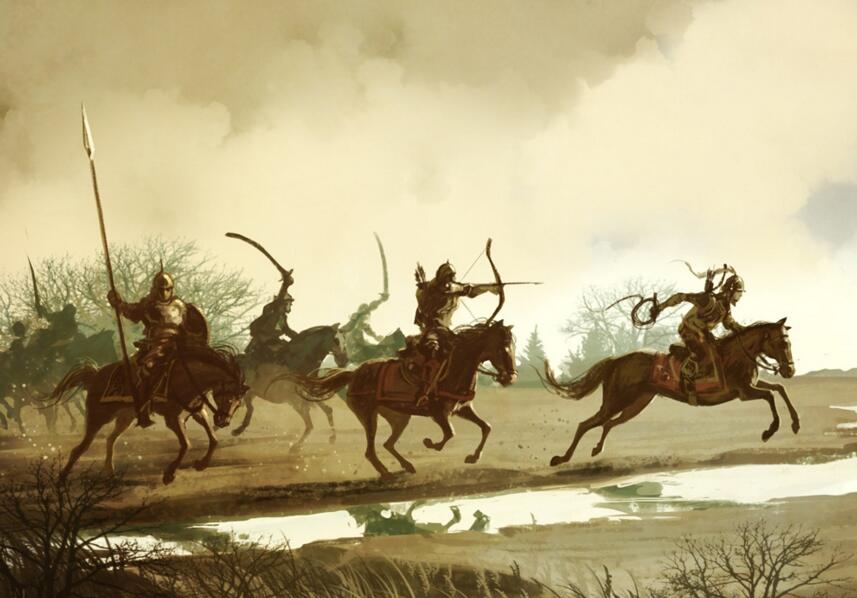 讨论:为何骑兵这么有用?
讨论:为何骑兵这么有用?
正文翻译

Directing this question mostly to antiquity but not only: Why was cavalry units so effective during battles? Dont get me wrong, I'm a huge fan of history and I know that it WAS effective but I can't really imagine why.
这个问题主要是针对古代,但也不完全是针对古代,为什么骑兵部队在战斗中这么有用?别误会,我是历史爱好者,我当然知道骑兵很有用,但我真的想不出原因。
Horses are (in my eyes) quite easily startled/scared. It's harder to fight on a horseback, you are a bigger target and it was hard and expensive to armour up a horse. Shields are not easy to carry on a horse. Most armies was composed of spears and in my eyes that is a good anti-horse weapon. Elephants were quite easily countered with whistles and lines by Scipios armies during second punic war, why was it tougher to face the Numidian cavalry? Horses are not smarter nor braver than elephants.
在我看来,马匹很容易受到惊吓,骑在马背上更难以作战,容易成为目标,给马装上防具又非常贵,在马上也不好带盾牌。大多数军队都是由长矛组成的,在我看来,长矛这种武器能很好的防御马匹。在第二次布匿战争中,大象很容易就被大西庇阿的军队用哨子和队列弄得反戈了,为什么骑兵就更困难呢?马匹并不比大象聪明勇敢。
But even after this, we know for a fact that cavalry was one of the most important factors and many times the reason why you won/lost. Please try to explain detailed but simple to me so I can picture it in my head.
但即使有如此疑问,我们也知道骑兵是战争中最重要的因素之一,很多时候也是导致你胜败的原因。请大家简洁明了的解释一下,以便我能在脑海里想象出来。

Directing this question mostly to antiquity but not only: Why was cavalry units so effective during battles? Dont get me wrong, I'm a huge fan of history and I know that it WAS effective but I can't really imagine why.
这个问题主要是针对古代,但也不完全是针对古代,为什么骑兵部队在战斗中这么有用?别误会,我是历史爱好者,我当然知道骑兵很有用,但我真的想不出原因。
Horses are (in my eyes) quite easily startled/scared. It's harder to fight on a horseback, you are a bigger target and it was hard and expensive to armour up a horse. Shields are not easy to carry on a horse. Most armies was composed of spears and in my eyes that is a good anti-horse weapon. Elephants were quite easily countered with whistles and lines by Scipios armies during second punic war, why was it tougher to face the Numidian cavalry? Horses are not smarter nor braver than elephants.
在我看来,马匹很容易受到惊吓,骑在马背上更难以作战,容易成为目标,给马装上防具又非常贵,在马上也不好带盾牌。大多数军队都是由长矛组成的,在我看来,长矛这种武器能很好的防御马匹。在第二次布匿战争中,大象很容易就被大西庇阿的军队用哨子和队列弄得反戈了,为什么骑兵就更困难呢?马匹并不比大象聪明勇敢。
But even after this, we know for a fact that cavalry was one of the most important factors and many times the reason why you won/lost. Please try to explain detailed but simple to me so I can picture it in my head.
但即使有如此疑问,我们也知道骑兵是战争中最重要的因素之一,很多时候也是导致你胜败的原因。请大家简洁明了的解释一下,以便我能在脑海里想象出来。
评论翻译

Directing this question mostly to antiquity but not only: Why was cavalry units so effective during battles? Dont get me wrong, I'm a huge fan of history and I know that it WAS effective but I can't really imagine why.
这个问题主要是针对古代,但也不完全是针对古代,为什么骑兵部队在战斗中这么有用?别误会,我是历史爱好者,我当然知道骑兵很有用,但我真的想不出原因。
Horses are (in my eyes) quite easily startled/scared. It's harder to fight on a horseback, you are a bigger target and it was hard and expensive to armour up a horse. Shields are not easy to carry on a horse. Most armies was composed of spears and in my eyes that is a good anti-horse weapon. Elephants were quite easily countered with whistles and lines by Scipios armies during second punic war, why was it tougher to face the Numidian cavalry? Horses are not smarter nor braver than elephants.
在我看来,马匹很容易受到惊吓,骑在马背上更难以作战,容易成为目标,给马装上防具又非常贵,在马上也不好带盾牌。大多数军队都是由长矛组成的,在我看来,长矛这种武器能很好的防御马匹。在第二次布匿战争中,大象很容易就被大西庇阿的军队用哨子和队列弄得反戈了,为什么骑兵就更困难呢?马匹并不比大象聪明勇敢。
But even after this, we know for a fact that cavalry was one of the most important factors and many times the reason why you won/lost. Please try to explain detailed but simple to me so I can picture it in my head.
但即使有如此疑问,我们也知道骑兵是战争中最重要的因素之一,很多时候也是导致你胜败的原因。请大家简洁明了的解释一下,以便我能在脑海里想象出来。

Directing this question mostly to antiquity but not only: Why was cavalry units so effective during battles? Dont get me wrong, I'm a huge fan of history and I know that it WAS effective but I can't really imagine why.
这个问题主要是针对古代,但也不完全是针对古代,为什么骑兵部队在战斗中这么有用?别误会,我是历史爱好者,我当然知道骑兵很有用,但我真的想不出原因。
Horses are (in my eyes) quite easily startled/scared. It's harder to fight on a horseback, you are a bigger target and it was hard and expensive to armour up a horse. Shields are not easy to carry on a horse. Most armies was composed of spears and in my eyes that is a good anti-horse weapon. Elephants were quite easily countered with whistles and lines by Scipios armies during second punic war, why was it tougher to face the Numidian cavalry? Horses are not smarter nor braver than elephants.
在我看来,马匹很容易受到惊吓,骑在马背上更难以作战,容易成为目标,给马装上防具又非常贵,在马上也不好带盾牌。大多数军队都是由长矛组成的,在我看来,长矛这种武器能很好的防御马匹。在第二次布匿战争中,大象很容易就被大西庇阿的军队用哨子和队列弄得反戈了,为什么骑兵就更困难呢?马匹并不比大象聪明勇敢。
But even after this, we know for a fact that cavalry was one of the most important factors and many times the reason why you won/lost. Please try to explain detailed but simple to me so I can picture it in my head.
但即使有如此疑问,我们也知道骑兵是战争中最重要的因素之一,很多时候也是导致你胜败的原因。请大家简洁明了的解释一下,以便我能在脑海里想象出来。
很赞 3
收藏